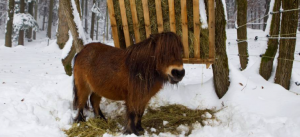 Evaluating hay feeders for horses can help you reduce waste. As one of the most common forages fed to horses, hay can be offered on the ground. It is also fed in a net, or in some type of feeder. Hay is often scattered and trampled by horses, reducing the percentage that is consumed when it is fed from the ground. Nets and feeders are designed to keep hay available, dry, and contained so it can be eaten rather than wasted.
Evaluating hay feeders for horses can help you reduce waste. As one of the most common forages fed to horses, hay can be offered on the ground. It is also fed in a net, or in some type of feeder. Hay is often scattered and trampled by horses, reducing the percentage that is consumed when it is fed from the ground. Nets and feeders are designed to keep hay available, dry, and contained so it can be eaten rather than wasted.
Various feeder types and designs have been developed for use with horses. A recent study, conducted by researchers at the University of Minnesota and supported by a grant from AQHA, was designed to compare hay waste among several square‐bale feeders used for outdoor feeding of adult horses. Feeder designs included a hay rack, a slat feeder, and a basket feeder. A control situation (hay fed on the ground) was also evaluated.
The Study:
Two feeders of each type were placed in separate outdoor paddocks. Twelve adult horses were divided into four groups of three horses. The groups were rotated through the four paddocks for seven-day periods. Two daily feeding of grass hay were provided, each containing half of an amount equal to 2.5% of the herd’s total body weight. Before each feeding, all uneaten hay left in the feeder and lying on the ground was collected and weighed, and the percentage of wasted hay was calculated.
Using a purchase value of $250 (USD) per ton of hay, the researchers determined the time required to equal the cost of each type of feeder with non-wasted hay. Efficiency of feeders was also compared to the no‐feeder control.
All feeders resulted in less hay waste compared with the no‐feeder control. Average hay waste levels were 1, 3, 5, and 13% for the slat, basket, rack, and no‐feeder control, respectively. The slat feeder was the most cost-effective option, paying for itself in nine months. The rack and basket feeders paid for themselves in 12 and 11 months, respectively. No injuries were observed from any of the small square‐bale feeders during the trial.
Results from this trial may help horse owners select hay feeders and may also assist in estimating how much hay should be purchased.
Interested in learning more about evaluating hay feeders for horses? Visit or call J & J Hay Farms for more information!
Article brought to you by Kentucky Equine Research.
